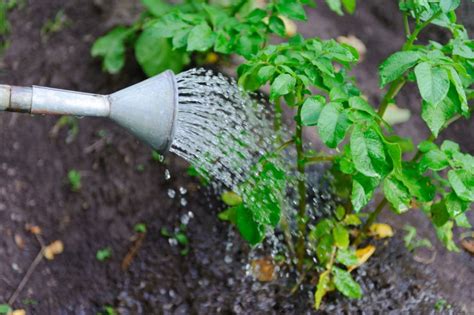How to Water Potatoes in Dry Conditions
Potatoes are a relatively drought-tolerant crop, but consistent moisture is crucial for optimal tuber development and yield, especially during dry conditions. Insufficient watering can lead to smaller potatoes, reduced yield, and even cracked or misshapen tubers. This guide provides comprehensive strategies for effectively watering potatoes in dry climates and during periods of drought.
Understanding Potato Water Needs
Potatoes require consistent soil moisture, particularly during the crucial bulking stage (approximately 6-8 weeks after planting). While they can tolerate some drought, prolonged dry spells severely impact growth and yield. The specific water needs vary based on several factors:
- Soil type: Sandy soils drain quickly, requiring more frequent watering than clay soils, which retain moisture longer.
- Climate: Hot, windy conditions increase evaporation, necessitating more frequent irrigation.
- Potato variety: Some potato varieties are more drought-tolerant than others. Check the seed packet for specific recommendations.
- Growth stage: Water needs are highest during the flowering and tuber bulking stages.
Watering Techniques for Dry Conditions
Several watering techniques can effectively manage potato irrigation in dry climates:
1. Drip Irrigation: The Most Efficient Method
Drip irrigation delivers water directly to the plant's roots, minimizing evaporation and water waste. This method is particularly beneficial in dry conditions, as it ensures the soil around the potatoes remains consistently moist without overwatering. Install drip lines along the potato rows, ensuring the emitters are positioned close to the plants.
2. Soaker Hoses: A Simple and Effective Solution
Soaker hoses are a low-cost alternative to drip irrigation. Place them along the rows, ensuring even moisture distribution. Soaker hoses are less efficient than drip irrigation because of potential water loss through evaporation and surface run-off. However, they are easier to install and maintain.
3. Deep Watering: Less Frequent, More Effective
Instead of frequent, shallow watering, opt for deep, infrequent watering. This encourages deep root growth, making the plants more drought-tolerant. Water deeply enough to moisten the soil to a depth of at least 6-8 inches. This requires less frequent watering and helps the potatoes access water from deeper soil layers during dry spells.
4. Mulching: Conserving Soil Moisture
Mulching the soil around the potato plants with organic materials like straw or hay helps retain soil moisture by reducing evaporation. A 2-3 inch layer of mulch will significantly improve water retention, reducing the frequency of watering required.
How Often Should I Water Potatoes in Dry Conditions?
There's no one-size-fits-all answer. Regularly check soil moisture by digging a few inches into the ground. If the soil feels dry, it's time to water. During hot, dry periods, you might need to water every 2-3 days, especially during the flowering and tuber bulking stages. Always monitor your plants and adjust your watering schedule as needed based on soil moisture levels, weather conditions, and the specific needs of your potato variety.
What are the signs of underwatering in potatoes?
H2: What are the signs of underwatering in potatoes?
Underwatered potatoes will exhibit several telltale signs:
- Wilting leaves: The leaves will droop and appear wilted, especially during the hottest part of the day.
- Stunted growth: The plants will grow slowly and may not reach their full potential size.
- Small tubers: The potatoes will be smaller than expected, with a reduced yield.
- Cracked or misshapen tubers: Severe water stress can lead to cracked or oddly shaped potatoes.
H2: How much water do potatoes need per week?
H3: It depends on several factors:
The amount of water potatoes need per week varies significantly depending on climate, soil type, and the growth stage of the plant. There's no magic number, and consistently monitoring soil moisture is key. Aim for consistently moist soil, but avoid waterlogging. During periods of high heat, you might need to water daily, while in cooler, more humid conditions, weekly watering might suffice. Observe your plants and adjust as needed.
H2: Can I overwater potatoes?
Yes, overwatering potatoes can be just as detrimental as underwatering. Excess water can lead to root rot and other fungal diseases, ultimately reducing your yield. Well-drained soil is crucial.
By implementing these techniques and carefully monitoring your potato plants, you can ensure they receive adequate water even during the driest periods, maximizing your yield and producing healthy, high-quality potatoes. Remember that consistent observation and adaptation to specific conditions are key to successful potato cultivation in dry environments.

